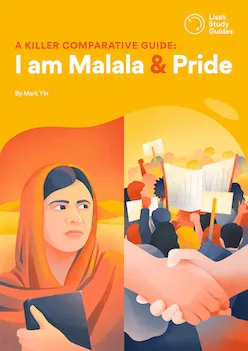The following is an excerpt from our study guide, I Am Malala and Pride, available for purchase here.
Plot Overview
I Am Malala
I Am Malala by Malala Yousafzai is a memoir of the eponymous Pakistani schoolgirl and activist. Yousafzai grows up in Pakistan’s Swat Valley with parents who are unconditionally supportive of her education. However, Pakistan is strongly under the control of the Taliban, an extremist group who opposes education for girls. On the other hand, Yousafzai’s family practice Islam in a peaceful and egalitarian manner.
Tracing how decades of global, geopolitical movements have produced these conditions, Yousafzai recounts the rise of the Taliban and her increasingly dangerous journey to school each day. The geopolitical histories trace back decades to the military rule of General Zia in the 1980s. Since then, turbulent domestic politics combined with a volatile, ever-evolving relationship with America (which, importantly, is partly America’s fault) has allowed the Taliban to rise to power. The post-9/11 period and the War on Terror are important milestones here, since these are the years in which Yousafzai grows up.
As the Taliban continue to deny women and girls their freedoms, Yousafzai becomes an outspoken activist, made all the more prominent by the BBC and the New York Times. Because of her fame, nationally and internationally, she becomes a target and is shot in the head by Taliban gunmen when she is just 15. The memoir starts here in its prologue, before going back in time to catch us up. Indeed, Yousafzai is now well-known everywhere for this incident.
The remainder of the book traces her recovery, and reaffirms her commitment to fighting for girls’ education. Even though she now lives in Birmingham, England, she has persevered through many setbacks to keep up the good fight - now on a uniquely far-reaching international platform.
Pride
Pride, directed by Matthew Warchus, is a film exploring the 1984-85 miners’ strike in Britain. In particular, it explores how an unlikely ally, the Lesbians and Gays Support the Miners (LGSM) organisation, is able to provide solidarity and support despite their differences.
At the time, many members of London’s LGBT community have difficult coming out experiences, made all the more difficult by stigma and dominating views of masculinity - they perceive miners in their hometowns as part of that problem. However, activist Mark Ashton sees an opportunity to help a group in need, and a group that is experiencing similar political pressures as themselves, particularly at the hands of Conservative Prime Minister Margaret Thatcher.
While the National Union of Mineworkers is initially reluctant to take LGSM’s money, Mark is able to connect directly with Dai Donovan, who represents miners from the Welsh village Onllwyn. Over time, LSGM is able to build relationships with locals, who gradually warm to their presence as well. Solidarity - the idea that anybody’s fight against injustice is everybody’s fight against injustice - is an important part of what makes this partnership tick. Their campaign culminates in the Pits and Perverts concert, which raises thousands of pounds.
The ending is a bittersweet one though - the mineworkers’ union finds this too controversial, rejects further support and ultimately loses the strike, while the queer activists return to their own struggles with identity and belonging. However, the campaign forged lasting bonds between these activists and miners, who show up in their own display of solidarity at the next year’s Pride March.
Themes, Ideas and Key Messages
At LSG, we use the CONVERGENT and DIVERGENT strategy to help us easily find points of similarity and difference. This is particularly important when it comes to essay writing, because you want to know that you're coming up with unique comparative points (compared to the rest of the Victorian cohort!). We don't discuss this strategy in detail here, but if you're interested, check out our How To Write A Killer Comparative study guide. We use this strategy throughout our discussion of themes below, and in the next section, Essay Topic Breakdown.
Similarities (CONVERGENT Ideas)
Identity and Perspective: Before even considering the activism that is featured in each text, it’s worth unpacking the individual identities of the main characters, and the complexities that come with them. Both texts see characters juggle and negotiate tensions within their identity - in particular, other people who share the identity don’t always see eye to eye with them. In I Am Malala, Yousafzai often finds herself at odds with other practitioners of Islam, especially the more extreme Taliban who would oppose her belief in girls’ education. Likewise, queer activists in Pride’s LGSM draw incredulity from their peers, who bristle at the idea of supporting the mineworkers. However, not only are these characters able to overcome these tensions, but their personal identities give them a perspective that feeds back into their activism - they actually draw on their identity in their fight for justice. Yousafzai acknowledges that Muslims 'don’t [all] agree' (Chapter 7), but she firmly believes that 'education for females not just males is one of our Islamic rights' (Chapter 23). Her fight is informed by, rather than separate from, her faith. In the film, Pride, personal identity also acts as a springboard for activism. For example, the collaborative and highly successful Pits and Perverts fundraiser came about as a result of the 'long and honourable tradition in the gay community [of] when somebody calls you a name…you take it and you own it'. Queerness is mobilised to fundraise for the miners, rather than silenced or excluded as others might have it.
Injustice and Activism: As we explored in the context sections (and as we’ve been exploring throughout), a fight for justice is fundamentally at the heart of both texts. In the film and the memoir alike, we see conservative agendas disempowering certain groups. Yousafzai recounts how pre-existing sexism in Pakistan, where girls found 'no point in going to school just to end up cooking, cleaning and bringing up children' (Chapter 3), was exacerbated by the Taliban who closed schools altogether. They would even vandalise and destroy schools - 'by the end of 2008, around 400 schools had been destroyed' (Chapter 11). Yousafzai’s fight is really about equality and human rights. The miners and LGSM are fighting their own injustices and inequalities in the film - Prime Minister Thatcher had been closing down mines and stripping miners of their livelihoods. Not only that, but she’d used pretty brutal tactics, calling in the police and withholding income support for newly-unemployed miners who struggled to feed their families through the winter.
Women’s Education: This isn't the principal fight in Pride, but there are moments where it definitely shines through. In particular, we first meet Sian as a young housewife, but by the end of the film Jonathan had encouraged her to return to school, and we know that she goes onto become the first female MP of her district. Through the strike, she discovered her own passion for trade unionism, and education hugely empowered her to take that passion further. This is particularly important given how much the strike affects men and women alike - consider the significance of ‘Bread and Roses’. In the memoir, the importance of women’s education is a much more central element. As Yousafzai points out, 'going to school wasn’t just a way of passing time, it was our future' (Chapter 11). In both texts, education helps people (and women in particular) forge relationships and futures for themselves, and for one another.
Differences (DIVERGENT Ideas)
Now it's your turn! Here are some questions to get you thinking about the differences between the two texts:
- Activism: What forms of activism are there? How effective can activism be? How are these ideas portrayed in the two texts?
- Solidarity: What does solidarity mean? What are the ways in which people can show solidarity? How are these ideas portrayed in the two texts?
Essay Topic Breakdown
Whenever you get a new essay topic, you can use LSG’s THINK and EXECUTE strategy, a technique to help you write better VCE essays. This essay topic breakdown will focus on the THINK part of the strategy. If you’re unfamiliar with this strategy, then check it out in How To Write A Killer Text Response.
Within the THINK strategy, we have 3 steps, or ABC. These ABC components are:
Step 1: Analyse
Step 2: Brainstorm
Step 3: Create a Plan
THINK
Compare how the two texts explore injustice.
Step 1: Analyse
This is a theme-based prompt. Both texts have a pretty clear focus on this idea of ‘injustice’, so it’s an important theme to have thought about beforehand. This prompt is quite broad, so you could potentially include a wide range of thoughts and opinions about injustice - you might want to consider angles like who is affected, what its impacts are and what actions can reasonably be taken against it. Also, because of how broad this prompt is, try to find answers to these questions from within the texts, but phrase them in a way that doesn’t necessarily refer to a text. This will help you keep your ideas flexible for both texts when the time comes to write.
Step 2: Brainstorm
I think those angles are a reasonable starting point for brainstorming. In the memoir, Yousafzai and her peers - Pakistani schoolgirls - are the most affected, while the injustices portrayed in the film affect coal miners and the LGBTQ+ community. All of these groups are disempowered and disenfranchised by injustice, and this is an important impact. Note that this is something you can say about both texts, which is exactly how we were trying to phrase our answers.
In terms of taking action against injustice, there’s a wide range of measures across the texts - speaking out, writing for news outlets, organising large-scale fundraisers, etc. - and the key takeaway from that might be how diverse these measures are, the different outcomes they generate and whether or not they’re effective.
Step 3: Create a Plan
Because this theme has a lot of rich overlaps between texts, it’s best to integrate discussion of both texts into every paragraph. When we do this for a theme-based prompt, especially a prompt with just one theme, that means every paragraph uncovers a new angle or dimension from both texts about the theme. Learn more about Integrated Text Discussion in How To Write A Killer Comparative.
P1: Injustice is framed as limiting people’s power - we can look at marginalised groups in both texts, from the schoolgirls of Yousafzai’s Pakistan, or the miners and the queer folk from the film.
P2: It’s also something that must be fought. Because it has such a detrimental impact, there is a need for those groups to stand up for themselves and for each other.
P3: In so doing, injustice may take time to overcome, but that doesn’t mean we shouldn’t fight it. Not all activism can be instantly, wildly successful - partial successes along the way are usually more frequent.
Our contention will try to string those three ideas together: injustice in any society involves some experiencing marginalisation and powerlessness that others do not experience (P1), and it is something that must be fought (P2), even if this is a time-consuming process (P3). Have a go at writing your own essay now if you’d like, or read a free preview of our I Am Malala and Pride study guide via the link below!
Resources
A Killer Comparative Guide: I Am Malala and Pride
How To Write A Killer Comparative Ebook
The Ultimate Guide to VCE Comparative
A Guide to Structuring a Reading and Comparing Essay
How To Get A+ in Reading and Comparing
Compare the Pair: A Guide to Structuring a Reading and Comparing Essay

















.jpg)